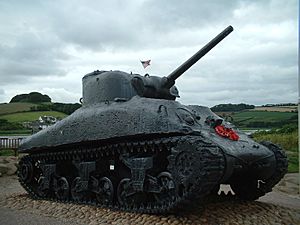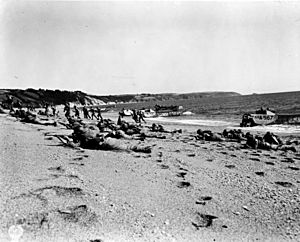Exercise Tiger facts for kids
Exercise Tiger, also known as Operation Tiger, was a very important practice run for the D-Day invasion. This invasion was a huge event where Allied forces landed in Normandy, France, during World War II. Exercise Tiger happened in April 1944 at Slapton Sands in Devon, England.
Sadly, there were some serious problems during this exercise. A mistake in communication led to soldiers accidentally firing on their own side. Even worse, German fast attack boats, called E-boats, attacked a group of American ships. These ships were getting ready for the practice landing. This attack caused the deaths of at least 749 American service members.
Because the real D-Day invasion was coming soon, everything about this incident was kept top secret. It was only talked about a little bit later on.
Contents
Preparing for the Invasion: Exercise Tiger
Practice Landings at Slapton Sands
In late 1943, as D-Day got closer, the British government set up a special training area. This was at Slapton Sands in Devon. It was used by American forces, known as "Force U," who were going to land on Utah Beach in Normandy. Slapton Beach was chosen because it looked a lot like Utah Beach. Both had a gravel beach, then a strip of land, and then a lake.
About 3,000 local people living near Slapton had to leave their homes. Some of them had never left their villages before. Practice landings started in December 1943. Exercise Tiger was one of the biggest practice runs, happening in April and May 1944.
The exercise was planned from April 22 to April 30, 1944. It covered every part of the invasion, ending with a beach landing at Slapton Sands. About 30,000 troops were on board nine large tank landing ships (LSTs). They got ready for their practice landing, which even included using live ammunition.
The Royal Navy was supposed to protect the exercise area. Four destroyers and several smaller patrol boats were watching the entrance to Lyme Bay. Other boats were stationed near Cherbourg, France, where German E-boats were based.
The first part of the exercise, from April 22 to 25, focused on getting troops and equipment ready. On the evening of April 26, the first group of assault troops got on their ships. The plan was to sail a long way around Lyme Bay. This would make it feel like crossing the English Channel, so they would arrive at Slapton at dawn on April 27.
Accidental Friendly Fire Incident
The first practice assault happened on the morning of April 27. But it began with a sad accident involving friendly fire. The planned time for the landing, called H-hour, was 7:30 AM. The exercise was supposed to use live ammunition. This was to help the troops get used to the sounds and smells of a real battle. During the landing, live rounds were to be fired over the heads of the incoming troops. This was ordered by General Dwight D. Eisenhower, the top Allied commander. He believed the men needed to experience real battle conditions.
However, several landing ships were delayed that morning. The American Admiral Don P. Moon decided to delay H-hour by 60 minutes, to 8:30 AM. But some of the landing craft did not get this message. They landed on the beach at the original time. The second group of ships came under fire from their own side. An unknown number of soldiers were hurt or killed. Rumors spread that as many as 450 men had died.
Battle in Lyme Bay
Quick facts for kids Battle of Lyme Bay |
|||||||
|---|---|---|---|---|---|---|---|
| Part of World War II | |||||||
 Arrow shows Lyme Bay in south-west England |
|||||||
|
|||||||
| Belligerents | |||||||
| Strength | |||||||
| 1 corvette 8 LSTs |
9 E-boats | ||||||
| Casualties and losses | |||||||
| 749 killed ~200 wounded 2 LSTs sunk 2 LSTs damaged |
none | ||||||
The day after the first practice landings, early on the morning of April 28, the exercise faced another disaster. A group of eight LSTs, carrying vehicles and combat engineers, was attacked by German E-boats in Lyme Bay. Nine German E-boats had left Cherbourg just after midnight. They managed to avoid the British patrol boats watching the area.
Around 1:30 AM, six E-boats spotted the eight dark ships. They split into groups to attack with torpedoes. The Germans were confused by the strange-looking ships, which didn't look like normal merchant ships. They thought they might be American landing ships with a shallow bottom.
Only one of the two ships meant to protect the convoy was there. HMS Azalea, a small warship called a corvette, was leading the LSTs in a straight line. This formation made them an easy target. The second ship, HMS Scimitar, a World War I destroyer, had crashed with an LST. It had left the convoy to be fixed. The American forces didn't know this because their radios were on different frequencies than the British naval headquarters. Another ship, HMS Saladin, was sent as a replacement, but it didn't arrive in time.
Sad Losses and Casualties
The German E-boat attack caused heavy losses:
- LST-289 caught fire but managed to get back to shore. 13 Navy personnel were lost.
- LST-507 was hit by a torpedo and sank. 202 US Army and Navy personnel died.
- LST-511 was damaged by friendly fire from another American ship. 18 US Army and Navy personnel were injured.
- LST-531 sank in just six minutes after being torpedoed. 424 Army and Navy personnel were lost.
The remaining ships and their escort fired back, and the E-boats stopped their attacks. In total, 749 service members were killed during Exercise Tiger. This included 551 from the United States Army and 198 from the United States Navy. Many soldiers drowned or died from hypothermia in the cold sea while waiting to be rescued.
Many of them didn't know how to put on their life jackets correctly. They often put them around their waist because of their large backpacks. This meant that when they jumped into the water, the weight of their packs flipped them upside down. Their heads were pulled underwater, and they drowned. Dale Rodman, who was on LST-507, said, "The worst memory I have is setting off in the lifeboat away from the sinking ship and watching bodies float by."
After the Attack: What Happened Next?
Important Changes for D-Day
Vice Admiral Kirk of the US Navy quickly understood how much damage E-boats could do to slow-moving landing craft. He worried that the German success in Lyme Bay could happen again on D-Day, which would be terrible. On May 4, 1944, he sent a message to Admiral Ramsay of the Royal Navy. He argued that Cherbourg, where the E-boats were based, needed to be heavily bombed from the air and sea.
"In my opinion the E-boats must be destroyed or driven from the Cherbourg area, prior to D-day. The only successful defense against the E-boat is to sink it before it can reach an attack position".
The attack was reported to Dwight D. Eisenhower on April 29. Eisenhower was very angry that the convoy was sailing in a straight line instead of zig-zagging. He was also worried that the attack reduced the number of available LSTs. It also showed the Germans that the Allies were almost ready to invade.
Even more concerning, ten American officers with secret D-Day knowledge were missing. These officers had BIGOT-level clearance, meaning they knew the invasion plans. If they had been captured alive, they could have given away the invasion secrets. Because of this, the invasion was almost called off until all ten officers' bodies were found. Eisenhower ordered that all their bodies and any secret papers they might have had be found.
The fact that exercises were happening at Slapton was interesting to the Germans. Some historians believe that Adolf Hitler insisted on reinforcing the Normandy area in May because he noticed how similar Slapton Sands was to the beaches in Normandy.
There were reports that E-boats were looking through the wreckage for information using searchlights. Shore batteries near Salcombe Harbour saw unidentified small boats. But they were told not to fire. This was to avoid showing the Germans that the harbor was defended.
Keeping the Secret and Lessons Learned
Because of the official embarrassment and worries about leaks before the real invasion, all survivors were told to keep quiet about what happened. There isn't much information about exactly how individual soldiers and sailors died. The US Department of Defense said in 1988 that records might not have been kept well on some ships. Also, the most important log books were lost at sea.
Several important changes came from the mistakes made during Exercise Tiger:
- Radio frequencies were made the same for all ships. The ships protecting the convoy were late because of radio problems. A warning about the E-boats was not picked up by the LSTs.
- Troops were given better training on how to use their lifejackets.
- Plans were made for small boats to pick up survivors floating in the water on D-Day.
Official histories don't have much information about this tragedy. Some people have called it a cover-up. But the initial need for secrecy about Tiger might have just led to it being quietly forgotten over time. Ken Small, an author, said in his 1988 book that the event "was never covered up; it was 'conveniently forgotten'."
The number of casualties from Tiger was not released until August 1944. This was along with the casualties from the actual D-Day landings. This report said there were 442 army dead and 197 navy dead, for a total of 639. However, Admiral Moon had reported 749 dead on April 30.
Memorials and Remembering the Fallen

Ken Small, a local resident in Devon, took on the task of remembering this event. He found evidence of the aftermath washed up on the shore in the early 1970s.
In 1974, Small bought the rights to a sunken tank from the U.S. Government. He had found this tank from the 70th Tank Battalion during his search. In 1984, with help from local people and diving companies, he raised the tank. It now stands as a memorial to the incident. The local government provided a base on the seafront for the tank. They also put up a plaque to remember the men who died. The American military honored and supported him. Ken Small passed away in March 2004, just a few weeks before the 60th anniversary of Exercise Tiger.
The memorial plaque at Slapton Sands reads:
"Dedicated by the United States of America in honor of the men of the US Army's 1st Engineer Special Brigade, the 4th Infantry Division, and the VII Corps Headquarters; and the US Navy's 11th Amphibious Force who perished in the waters of Lyme Bay during the early hours of April 28, 1944".
In 1995, a plaque called "Exercise Tiger Memorial" was put up at Arlington National Cemetery in the United States. In 1997, the Exercise Tiger Association created another memorial in Mexico, Missouri. It is a 5,000-pound anchor from an LST ship.
In 2012, a memorial plaque was placed at Utah Beach, Normandy, on the wall of an old German anti-aircraft bunker. An M4 Sherman tank also stands as a memorial to Exercise Tiger at Fort Rodman Park in New Bedford, Massachusetts.
In 2019, the US service members who died in the exercise were remembered with an art installation by artist Martin Barraud. Bootprints of 749 troops were laid out on Slapton Sands. This marked the 75th anniversary of Exercise Tiger. Mr. Barraud hoped that a bootprint would be bought in memory of every soldier, sailor, and airman who gave their lives.


